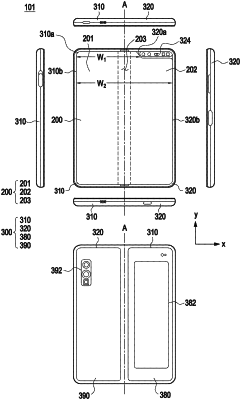| CPC G09G 3/2096 (2013.01) [G06F 1/1616 (2013.01); G06F 1/1641 (2013.01); G06F 1/1652 (2013.01); G06F 3/1446 (2013.01); G09G 2340/0407 (2013.01); G09G 2340/0442 (2013.01)] | 14 Claims |

|
1. A portable communication device comprising:
a housing comprising a first housing structure, a first rear cover, a second housing structure, and a second rear cover, wherein the second housing structure is rotatable with respect to the first housing structure such that the housing is movable between a folded state and an unfolded state, and wherein at least part of the first housing structure and at least part of the second housing structure face to each other while the housing is in the folded state;
a first display having a first resolution and a first size, and viewable through an area of the first rear cover;
a second display separate from the first display having a second resolution higher than the first resolution and a second size larger than the first size, and being accommodated by the first housing structure and the second housing structure to be viewed when the housing is in the unfolded state;
at least one processor; and
a memory storing instructions which, when executed by the at least one processor, cause the portable communication device to:
display, through the first display, a first screen of an application which has the first resolution and the first size, while the housing is in the folded state,
based on the housing being changed from the folded state to the unfolded state:
display, through the second display as a transition image, an enlarged image of at least a portion of the first screen which was displayed through the first display before being changed to the unfolded state, and
after the enlarged image is displayed, replacing, on the second display, the enlarged image with a second screen of the application which has the second resolution and the second size corresponding to the second display,
wherein the second screen is different from the first screen.
|